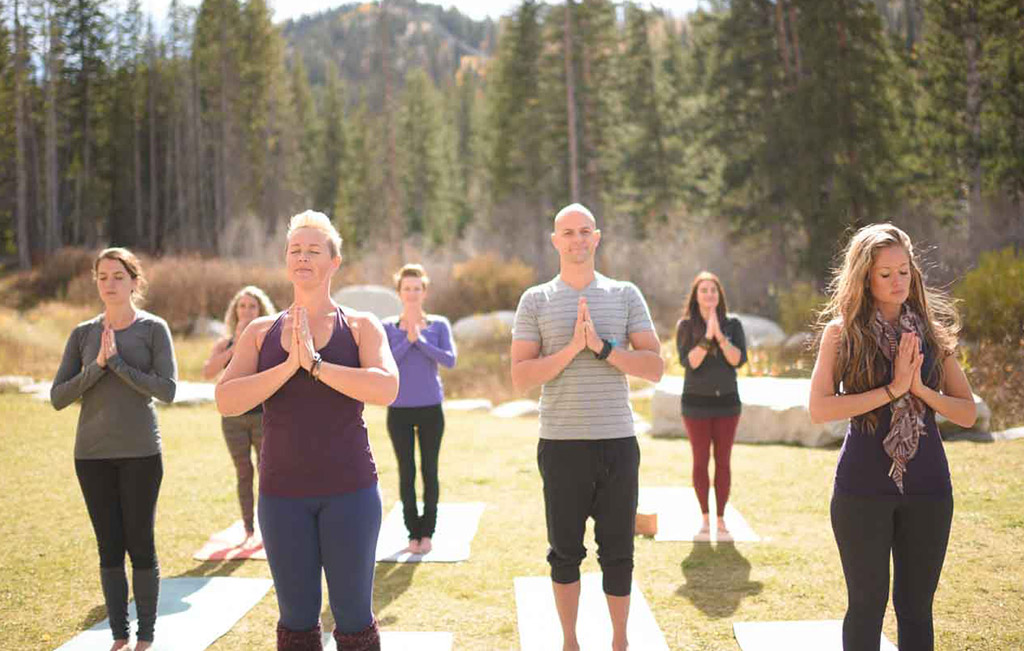
Take a minute to look at a tree, any tree. Look at the skeleton—the trunk and branches. Then study the leaves, in essence the “flowers” of the tree. Picture a rose bush laden with blooms or a single spring tulip. The flowering that you see in these things is possible because of what you don’t see—the vast system of roots that anchors each to the earth, roots that are often more complex and expansive than the branches and blooms they support.
Almost 30 years ago, I had the good fortune to travel to India, the place where the ancient system of yoga first took root. For three weeks, I studied at the Ramamani Iyengar Memorial Yoga Institute with B.K.S. Iyengar and his daughter, Geeta, as part of a group of 30-some serious students and teachers from all over the U.S. With only eight years of practice behind me, I was a novice in the group.
The Iyengars are known for their careful attention to alignment. Some of the more experienced students in the group grew impatient with the endless hours we spent on the minutiae of what many thought of as “less advanced” poses. I was spellbound, however, and hoped I would leave India with a rudimentary understanding of the root of all yoga poses: Tadasana.
Also called Mountain Pose, Tadasana is the foundation from which all other asanas blossom. If you understand Tadasana, and practice its principles, you can find your way into just about any other pose and know that your physical structure—your skeleton—is giving you the most efficient support possible.
There’s a multitude of theories about body alignment in yoga. In sharing the following ideas, I do not mean to refute or contradict any other methods. There are many ways to approach alignment, each of which speaks to different individuals. What follows are simple instructions, based on my own experience in practice, and on wisdom I’ve learned along the way from several of my teachers. Some individuals might require more detailed instructions to accommodate body type variations.
Practicing Tadasana
- Begin by standing on a nonskid yoga mat with your feet hips-width apart. Feel how your feet meet the floor. Are you feeling more weight on one foot than the other, on the balls of your feet or your heels, or on the insides or outsides? Play with your weight distribution until you feel balanced over both feet. Imagine your feet sending down roots into the ground.
- Now move your awareness up to your abdomen. Are you tightening your abdomen and buttocks? If so, relax them so that you can breathe freely.
- Now become aware of your hip joints, the creases of each joint, where the fronts of your thighs and pelvis meet. Place your fingers gently into the creases, and feel the tendons there. Are they hard or tight? If so, move the hip joints back and allow your pelvis to tilt forward until the tendons feel springy. It will feel as if your rear is sticking out, but what is actually happening is that you are bringing your pelvis into an alignment that allows your legs to be vertical and for the spine to relax into its natural curves. (If you have a tendency to lock or hyperextend your knees, this pelvic position will keep this potentially damaging misalignment from happening.)
- Feed your pelvis down into your legs, and simultaneously lift the whole ribcage, front and back. Let your shoulder blades slide down your back toward your pelvis so that your neck feels long. Let your arms hang at your sides or if you prefer, place your palms together—gently but firmly—at your breastbone.
- Move your head slightly forward and back to find the center, the place where your brain feels easy and spacious. Imagine the center points of your pelvis, ribcage and skull vertically aligned with each other.
Tending to Our Spinal Curves
Our spines have four curves—two convex and two concave. The convex curves are at the sacrum and thorax (the part of the spine attached to the ribcage), and the concave curves are at the lumbar (low back) and at the neck (cervical spine). These curves act as shock absorbers, and give support to the pelvis, ribcage and head and their important contents, the vital organs.
The sacrum is a large, flat bone at the base of your spine, just above your tailbone. It sits between the two halves of the pelvis, just below your lower back. The angle of the sacrum determines the depth of the curves in the rest of your spine. A sacral angle of about 30 degrees is optimal for healthy spinal curves. When you draw your hip joints back and tilt your pelvis forward (as above), the sacrum can sit at a 30-degree angle. Because the sacrum and pelvis are at the intersection of lower and upper body, their alignment affects all the structures above and below. Optimal alignment of the pelvis and sacrum allows for the most efficient movement of force through your bones.
To test your alignment, check your breathing. If your breathing is shallow or labored, adjust your pelvic tilt and relax your abdomen until your breath feels relaxed and full, and your body oscillates with each inhalation and exhalation. When your body is aligned optimally in Tadasana, your body and mind will feel at ease, and your breathing will be free and full.
The yoga sutras say that yoga poses should be “steady and comfortable.” Steadiness and comfort happen when the skeleton is in optimal alignment, and the muscles lengthen along the bones. Being at ease in Tadasana is the root of being at ease in all yoga asanas. Return to this root often when you practice. Explore the effortless body and quiet mind of Tadasana whether you’re practicing yoga or standing in line at the grocery store. Let Tadasana provide the foundation for an easeful life.
Updated article from February 3, 2017.
